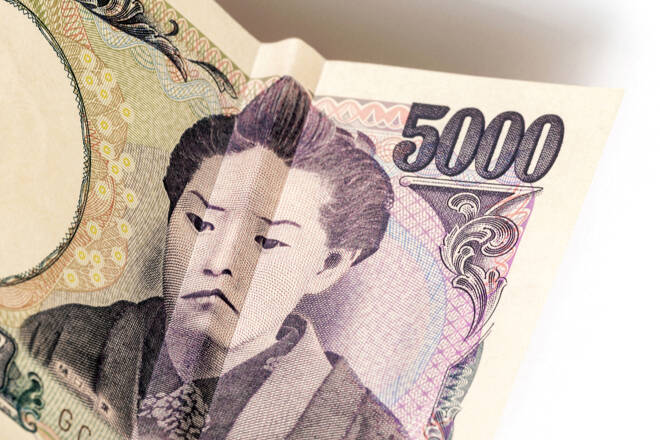Advertisement
Advertisement
Japanese Yen and Aussie Dollar Forecasts: Risk-Off Mood Builds on Fresh Tariffs
By:
Key Points:
- Escalating global trade tensions boosted safe-haven demand for the Japanese Yen, weighing on USD/JPY.
- US-Japan tariff talks could influence BoJ policy outlook; unresolved disputes may leave a 24% tariff on Japan exports.
- Bank of Japan Governor Kazuo Ueda will speak on April 9, with insights on the Bank's policy stance crucial for the Yen.
Japan Consumer Confidence and the BoJ in Focus
Japan’s consumer confidence trends, on Wednesday, April 9, will influence USD/JPY trends and the Bank of Japan’s policy stance. Economists forecast the Consumer Confidence Index to drop from 35 in February to 34.7 in March.
A larger-than-expected fall in confidence may signal weaker consumer spending. Softer spending could dampen demand-driven inflation, easing pressure on the BoJ to raise interest rates.
Conversely, an unexpected jump in sentiment could indicate stronger spending, potentially driving inflationary pressures. Rising inflation would likely support an H1 2025 Bank of Japan rate hike.
Beyond consumer confidence, tariff developments remain a key consideration. Progress toward a US-Japan trade agreement could boost optimism toward Japan’s economy, supporting job creation and wage growth. However, failure to secure a trade agreement would leave a 24% tariff on Japanese goods bound for the US. Tariff-driven economic uncertainty may test bets on a near-term BoJ rate hike.
Despite economic and monetary policy uncertainty, escalating trade tensions could drive demand for safe-haven assets, including the Japanese Yen. However, a de-escalation could soften Yen’s demand.
With tariffs in focus, BoJ Governor Kazuo Ueda is expected to offer insights on inflation, monetary policy, and trade-related risks later today.
USD/JPY Trends to Watch:
- Bullish Yen Scenario: Upbeat Japan consumer confidence, an escalation in the global trade war, risk-off sentiment, or hawkish BoJ rhetoric may pull the USD/JPY pair toward the 140.309 support level.
- Bearish Yen Scenario: Weaker consumer confidence, easing trade tensions, improving risk sentiment, or dovish BoJ signals could drive the USD/JPY pair toward the 149.358 resistance level.
USD/JPY Daily Outlook: Fed Commentary in Focus
Later in the US session, Fed commentary may influence US dollar demand. FOMC member support to delay rate cuts pending trade clarity could boost US dollar demand. In this scenario, the USD/JPY pair could move toward the 149.358 resistance level. Conversely, support for multiple rate cuts may weaken US dollar demand, potentially pulling the pair toward the April 4 low of 144.546.
Meanwhile, tariff developments will continue to influence USD/JPY trends.
Explore expert forecasts and trade setups for USD/JPY in our latest market analysis here.
Shifting focus to the Australian Dollar, stimulus measures in China, and ongoing trade tensions are back in the spotlight.
AUD/USD Outlook: Building Permits, Tariffs, and China
Turning to AUD/USD, the Aussie housing sector will be in focus early in the Wednesday session. According to preliminary reports, building permits fell 0.3% month-on-month in February after rising 6.9% in January, while private house approvals rose 1%, down from 1.4% in January.
Economists consider housing sector data a leading indicator of the Aussie economy. Upward trends in housing approvals suggest a favorable demand environment, potentially pushing house prices higher. Rising house prices could boost consumer confidence, spending, and inflation.
However, tariff developments clouded market sentiment. Overnight, President Trump affirmed the roll out sweeping tariffs, raising levies on Chinese imports to 104%. With China accounting for one-third of Australian exports and Australia’s trade-to-GDP ratio above 50%, reduced demand for goods may affect the Aussie economy. A deteriorating economic outlook may raise expectations of multiple RBA rate cuts, pressuring the AUD/USD pair.
For a comprehensive analysis of AUD/USD trends and trade data insights, visit our detailed reports here.
Australian Dollar Daily Outlook: Fed Policy in Focus
In the US session, FOMC member chatter will influence AUD/USD. Hawkish remarks could widen the US-Aussie interest rate differential in favor of the US dollar. A wider rate differential may drag the AUD/USD pair below $0.59 toward the upper band of the descending channel.
Conversely, dovish rhetoric may narrow the rate differential, potentially driving the pair toward the April 7 high of $0.61268.
Key Market Trends
The main drivers of the forex market include:
- USD/JPY: BoJ forward guidance and consumer sentiment impact.
- USD/JPY and AUD/USD: US inflation, Fed chatter, global trade developments.
- AUD/USD: Beijing’s stimulus measures and tariff developments between the US and China and the US and Japan.
Do not miss today’s trade setups in our full USD/JPY and AUD/USD reports.
About the Author
Bob Masonauthor
With over 28 years of experience in the financial industry, Bob has worked with various global rating agencies and multinational banks. Currently he is covering currencies, commodities, alternative asset classes and global equities, focusing mostly on European and Asian markets.
Did you find this article useful?
Latest news and analysis
Advertisement
